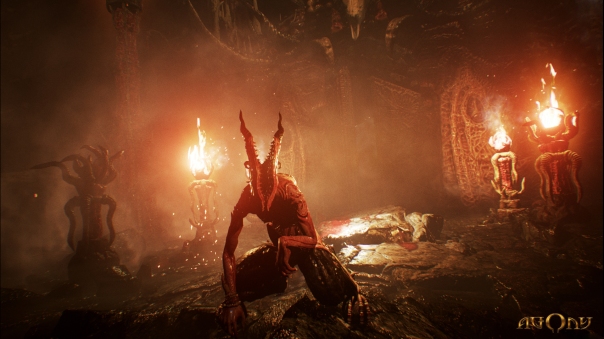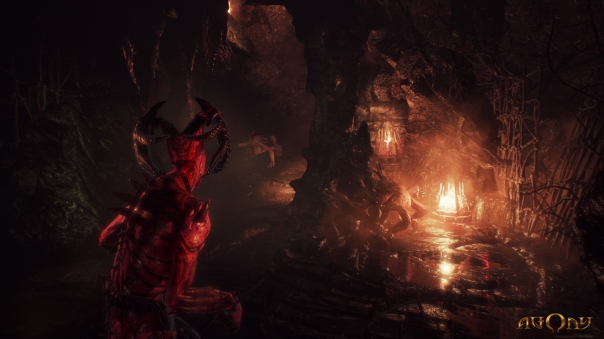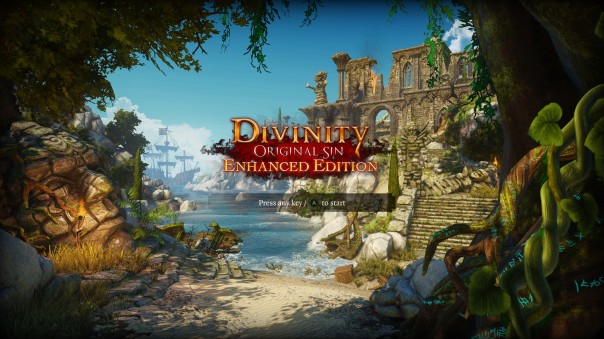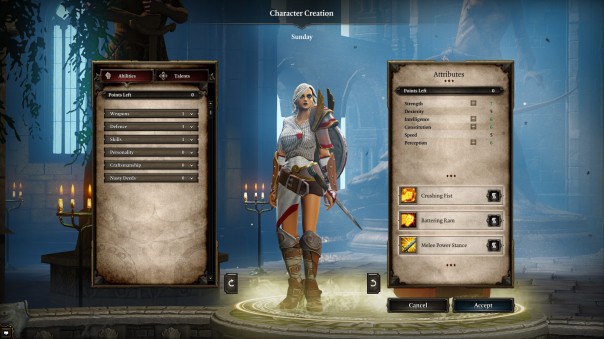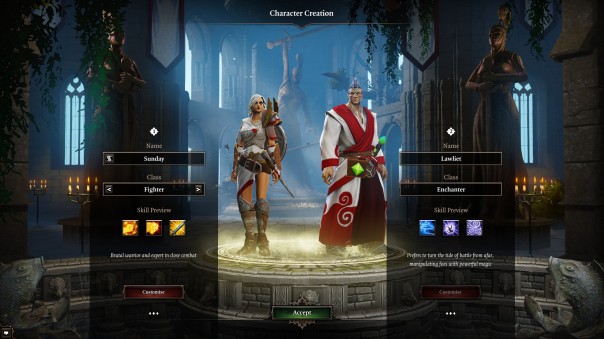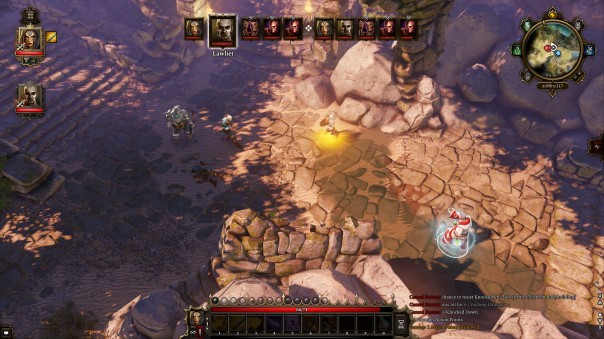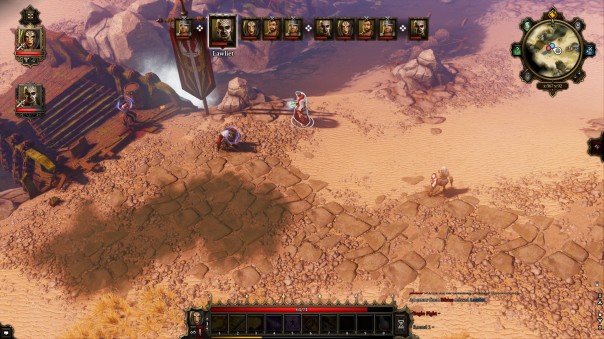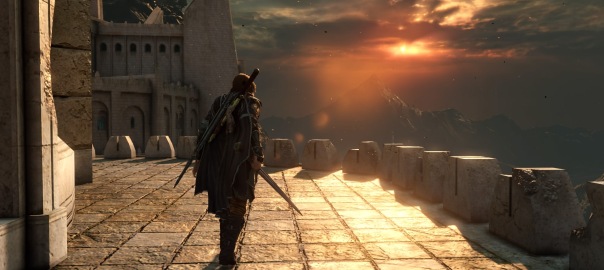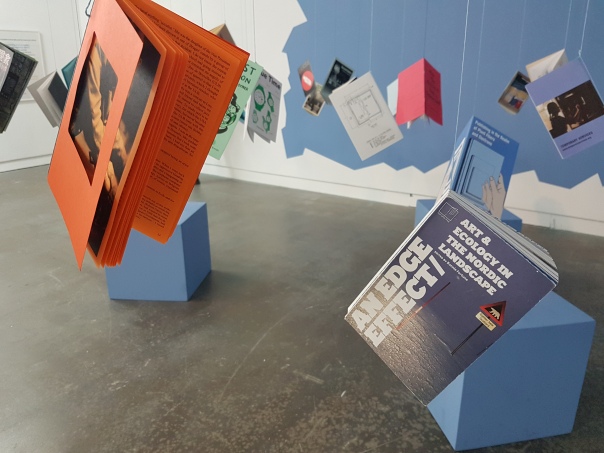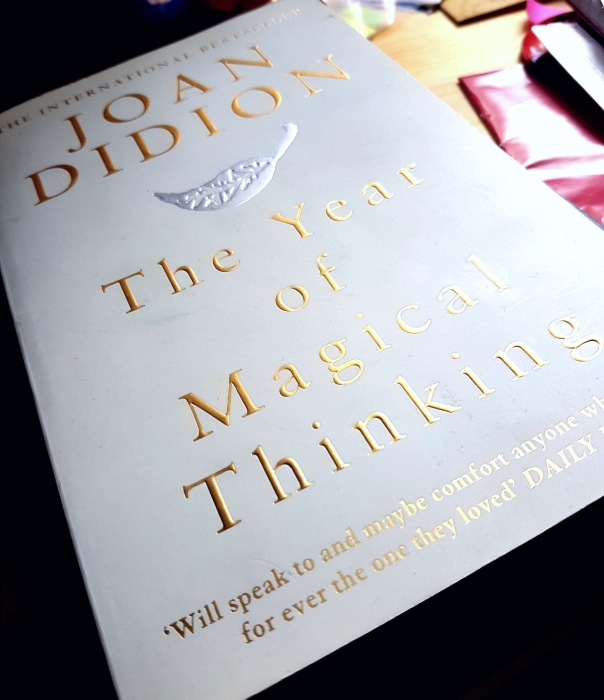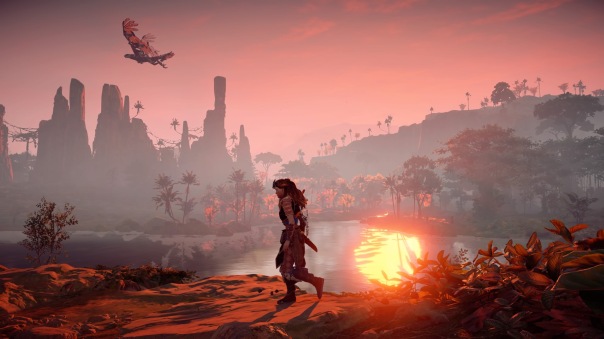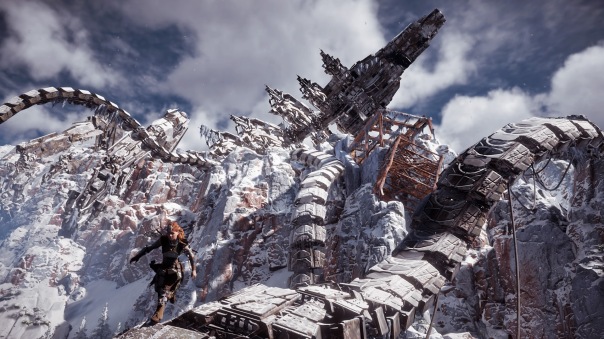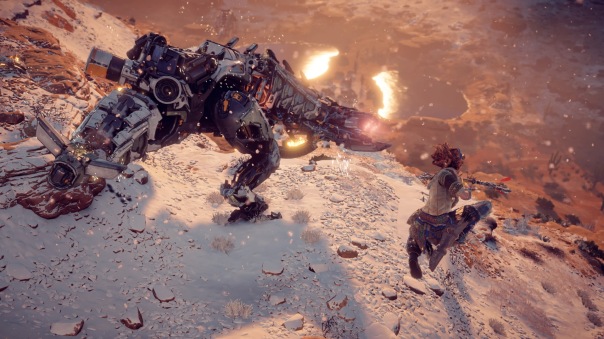Okay, let’s try again. Riding rings around the swooping creature circling my position, I reach the open stretch of ground once more- perfect! I pause the game, select Photo Mode, observe my options. I adjust the position of the camera, putting myself slightly off-centre in the middle ground, amplifying the size difference between Wander and the colossus he’s chasing, arrow nocked, bow stretched. The camera is practically on the ground, the ratio of land to sky almost half and half. Slightly too harsh with the sunlight, though. I flick through the menus until I reach the filters, setting it to a less vibrant option. Now instead of a harsh midday top light, we get a nice dusky haze, which contrasts nicely with the white balloon shapes on the creature’s body. I adjust the contrast to make sure Wander and Agro don’t get lost among the more muted shades of the ground around them, then hide the menu. Click the share button, press Triangle. Perfect action shot.
*
It’s no surprise so many games are adding photo modes these days. After all, with the rise of 4K gaming, high fidelity graphics, HDR and other buzzterms adding to the awe-inspiring vistas of many releases, games these days are just so damn pretty. And boy, do we know it: PC Gamer recently released a gallery of its favourite screenshots. Graphically speaking, we’ve reached a peak of artistic achievement we’re unlikely to progress too far past. But is that the only reason for including a Photo Mode? To maximise the aesthetic potential of your game? After all, a simple screenshot would do if you were looking to capture a glitch or a happenstance, or even a nice view in a pinch. There’s another reason: with the inclusion of Photo Mode, games want to bring you as close as possible to the constructedness of their worlds.
This slideshow requires JavaScript.
Bound, a game whose Photo Mode lets you accentuate its stylised presentation, even features a Trophy for first entering it.
Upon the invention of the camera, its ultimate purpose was to capture a realistic depiction of the world, to capture things as they were. Of course, in the age of Photoshop, we’ve moved beyond such limited ambitions. Two seconds on Instagram will grant you access to wonderfully inventive, beautifully composed photos, perfectly manipulated to achieve maximum dark/light ratios, complementary colour palettes, leading lines, etc. After all, why capture the world as it is when you can make it better? Photo Mode functions similarly: it brings the aesthetic potentialities of the camera lens into worlds beyond our own, giving the photographer’s eye access to realms beyond reality. As Susan Sontag suggests in her landmark book On Photography:
It is as if photographers, responding to an increasingly depleted sense of reality, were looking for a transfusion- travelling to new experiences, refreshing the old ones. Their ubiquitous activities amount to the most radical, and the safest, version of mobility. The urge to have new experiences is translated into the urge to take photographs: experience seeking a crisis-proof form.
Of course, despite my liberal use of Photo Mode, I’d never consider myself a photographer. But you can see the appeal. Sontag frames the appeal of photography as a response to changing social conditions and art forms, inviting the desire to make the old new again. ‘Experience seeking a crisis-proof form’ is perfect for the videogame, itself an experience which offers new realities, new experiences. Photo Mode is therefore a way of immortalising these constructed realities; an accessible means of capturing and aestheticising another form of mobility.
This slideshow requires JavaScript.
The PS4 Remaster of Shadow of the Colossus allows for maximum aesthetic…or hilarity.
Thanks to this new aestheticisation, I seem to spend more time tweaking photos than I do playing. It’s a style of play I’ve taken to calling Photo Mode Mode. Like a performance within a performance, I find myself going out of my way to style a shot, playing to the camera I’ll inevitably insert into the action. As every lifestyle blogger will tell you, experiencing life through the lens of a camera is not experiencing life. Games are big enough, some may say. Why bloat the experience further with a gallery of pictures clogging up your console’s memory? Well, because it’s fun. Very rarely can an art form give you such ready access to a means of creation, especially with the deftness with which games have integrated Photo Mode. There may not be a career in it, but it’s an exciting new form for capturing our experiences.

Middle-earth™: Shadow of Mordor™_20150801115927

Middle-earth™: Shadow of Mordor™_20150802005904

Horizon Zero Dawn™_20170320220601

Horizon Zero Dawn™_20170313213627
Look at the experiences I captured!
But what goes into the creation of these new photographic forms? How do they draw attention to the construction of these worlds? Beyond the interplay of light and shadow, beyond stepping out of a cave to be greeted by a beautiful landscape or seascape, what governs the tastes behind the desire to capture these new realities, and how do its creators respond? The discovery that the remastered edition of The Legend of Zelda: Wind Waker featured a selfie mode in which Link could espouse a number of comical facial expressions caused an internet sensation. A similar selfie mode in Grand Theft Auto V immediately reached its zenith as a means of juxtaposing the mundane and the fantastic when selfies emerged of Franklin or Michael smiling as an explosive pile-up occurred on the road behind them. Like the game itself, Photo Modes don’t exist just to capture their respective worlds as they are; they can be used to emphasise their estrangement from ‘reality’.
They achieve this in part due to their complicity with a game’s systems. Photo Mode complements the notion of player agency, injecting them into a world with the knowledge that they have (to an extent, at least) the power to change it. Photo Mode foregrounds the deference the player character exhibits towards the player. It’s a complication of Roland Barthes’ musings on being photographed in his famous work Camera Lucida:
I lend myself to the social game, I pose, I know I am posing, I want you to know that I am posing, but (to square the circle) this additional message must in no way alter the precious essence of my individuality, apart from any effigy.
In Photo Mode, this essence is already altered: the characters being photographed are already effigies; the pose is already a pose; the work of an animator and an artist. The subject or object of the photo is already subjected to the gaze, or the control, of the player. If I play Horizon: Zero Dawn or Middle Earth: Shadow of War, I recognise the limitations of the figures in their Photo Mode, that Aloy or Talion are representations, approximations of many parts: voice; model; texture; animation. The onus is on me to position the shot, to balance the tone. For the most part, the character isn’t able to pose for themselves (Aloy does gain limited posing options in a more recent patch for Horizon, an addition which throws more questions of subjectivity into the mix, issues I wouldn’t have the patience to work through in a short piece), therefore an action shot, such as the one I described in the introduction, becomes much harder to choreograph.
The end result is usually either beautiful or funny to look at. Here are a couple of shots I took from my playthrough of The Last of Us on PS4:

The Last of Us™ Remastered_20140808105903

The Last of Us™ Remastered_20140808221316
On the left, a relatively traditional shot, aesthetically pleasing, if I do say so myself. On the right, Joel remembering he’s left the stove on while up to his neck in a river. I’ve used Photo Mode to capture views and experiences, sometimes pretty, sometimes comical. In this case, Photo Mode acts like an embellishment, going beyond just capturing the moment and becoming a means of changing the moment as it happens. I can adjust the position of the sun in the sky, I can make characters invisible. Photos taken in this mode aren’t just a matter of ‘look what I did in this place’, but ‘look what I made this place do’. Player agency goes beyond the actions of an avatar, toward the actions of a god. We’re already used to this diluted form of egomania; puppeteering our characters; commanding tiny figures on a battlefield. All Photo Mode has done is extend this power to the world.
*
However, we’re getting ahead of ourselves. Most of the time, it just comes down to making pretty pictures, surely? Not at all. Photo Mode is our most entertaining method of exploring the games we play. Even just manipulating the Photo Mode camera can give you knew insights into how a game’s systems and designs are implemented, as Twitter found out when we discovered Shadow of War’s Talion was at the centre of every snowfall. The sense of freedom on offer in most Photo Modes is liberating: cel-shading, depth of field, borders, filters, all at your disposal. Every shot taken, no matter how awkward, busy, ugly, or hilarious, is a contribution to this weird new art form.
Photo Mode’s well-deserved renaissance also goes hand-in-hand with a renewed focus on how photos can be used in a game’s approach to story and character development. Prompto’s camera, which he uses independently throughout Final Fantasy XV, delivers an album of pictures which bring you closer to the lives of its main cast and emphasises its road trip themes. Life is Strange, which explores the potentiality of power in physical photographs, uses its pictures to investigate the effects of knowing every possible moral outcome in life’s decisions. Like story in games, like artistic ambition, like thematic exploration, critical interrogation, this feature is only just beginning to explore its own boundaries.
This slideshow requires JavaScript.
FFXV and Life is Strange show how photos can record memories…or miss opportunities.
I don’t regret a single second I’ve spent in Photo Mode. It’s part of the magic for me. In fact, I want to use it more: it can save a playthrough for me. Middle Earth: Shadow of War, for example, was a bloated monument to the best and worst of videogames; every landmark setpiece juxtaposed with an unwelcoming grind, every satisfying assassination offset by the nebulous threat of more loot crate drudgery. Arguably, its Photo Mode was its best feature.
My hope is that I can use Photo Mode to explore, to use it as a photographer would; not just picking out the best position of the sun in the sky to best compliment the silhouette of my leaping avatar, but to capture the elements we all take for granted in these constructed worlds. Let’s look beyond the role of the player and start looking at how the worlds they inhabit are shaped: a close-up portrait of a character’s face, the play of light on a blasted out wall, the interactions between NPCs around a fire. If they glitch out, if we immortalise something a developer never intended us to see, so much the better. If we can embrace these figures, these worlds, as constructs, and yet still recognise the depth of their creation, then we’ve succeeded. It’s time for them to join the social game, to enrich the fabric of the games we play. It’s time to capture new facets of these effigies, and imbue them with new layers of signification. Embrace Photo Mode Mode. Take a picture: it’ll last longer.
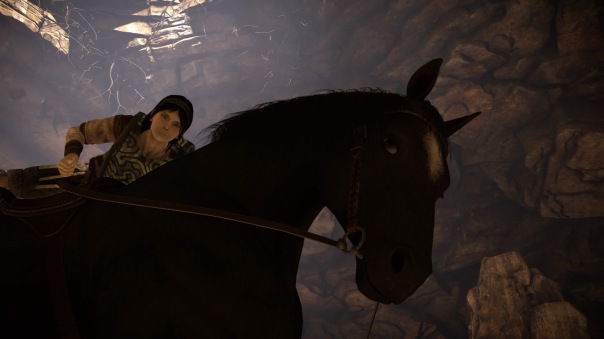
As if you needed any more proof of Photo Mode’s artistic portfolio, here’s Agro’s ‘come hither’ look. Boundless potential.
